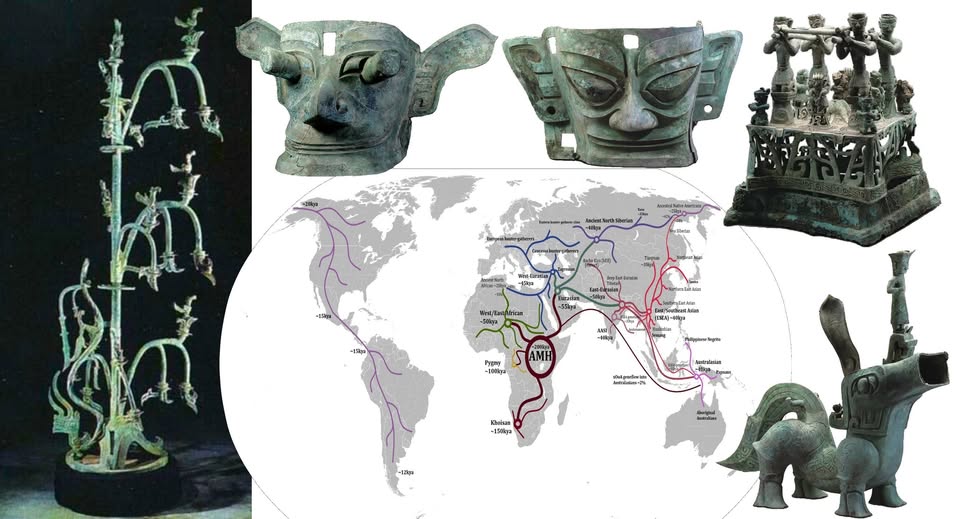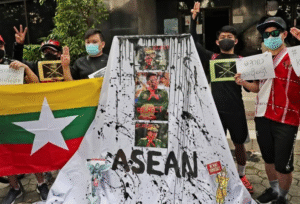The Sanxingdui culture and the Tibeto-Burman language family, incorporating archaeological, linguistic, and genetic findings.
Sanxingdui: A Bronze Age culture of the ancient Shu Kingdom

Origins and society
- A distinct civilization: From approximately 1700–1150 BCE, the Sanxingdui culture flourished in the Sichuan Basin, creating a sophisticated Bronze Age society that was contemporary with, yet culturally distinct from, the Shang dynasty in the Yellow River Valley. The discovery challenged earlier notions that the Yellow River civilization was the sole center of innovation in ancient China.
- Theocracy: The city itself was a large, walled settlement with specialized industrial, residential, and religious districts, suggesting a well-organized and strong theocratic state.
- Trade network: The people of Sanxingdui engaged in extensive trade. Finds of elephant tusks indicate links to South and Southeast Asia, while certain bronze and jade vessels show contact with other cultures in China, including the Shang and Yangtze River Basin civilizations.
Unique artifacts and rituals
- Unusual bronzes: The civilization is most famous for its stunning and unusual bronze artifacts, including large standing figures and striking masks with exaggerated features like bulging eyes, large ears, and prominent noses. These are believed to represent deities, ancestors, or mythical figures, and some interpretations link the bulging eyes to the legendary first king of Shu, Cancong.
- Ritual sacrifice: The many objects found in sacrificial pits were often deliberately burned or broken before burial, suggesting ritual practices intended for communication with the spirit world. The pits also contained large quantities of jade, gold, and ivory.
- Lack of writing: Despite its sophistication, no form of writing was found at the Sanxingdui site, which leaves many aspects of its history and belief system open to speculation.
Possible fate
- Sudden disappearance: The site was abruptly abandoned around 1150 BCE, the reasons for which remain unknown. Theories include environmental catastrophe, such as an earthquake or flood, or invasion.
- Successor civilization: Archaeological evidence suggests the culture may have migrated and relocated its capital to the nearby Jinsha site, where similar artifacts have been found.
The Tibeto-Burman language family
Origins and migration
- Origin in the Yellow River Basin: Recent linguistic and genetic studies, using computational phylogenetic analysis, suggest that the Sino-Tibetan language family originated in the Yellow River Basin in northern China approximately 5,900–7,200 years ago, coinciding with the rise of millet-based agriculture.
- Massive diversification: From this homeland, different groups of speakers dispersed and diversified. Unlike the relatively unified Sinitic (Chinese) languages, the Proto-Tibeto-Burman speakers fragmented into numerous groups as they moved into diverse and often isolated mountainous regions.
- Migration routes: Major migrations followed river valleys west into the Himalayan Plateau (leading to the Bodish languages like Tibetan) and southwest into Southeast Asia (leading to languages like Burmese, Lahu, and Karen). In Southeast Asia, Tibeto-Burman speakers often assimilated with indigenous Austroasiatic populations.
Present status
- Geographic spread and major languages: With over 400 distinct languages, the Tibeto-Burman family is spoken by tens of millions of people across a vast area, including the Tibetan Plateau, the Himalayas, Myanmar, Nepal, and northeastern India. The most prominent languages are Burmese (over 32 million speakers) and Tibetan (over 8 million speakers).
- Linguistic diversity: The language family displays immense internal diversity due to its historical dispersal into isolated geographic areas.
- Threat of extinction: Many of the smaller Tibeto-Burman languages are endangered, with small, isolated speaker populations increasingly pressured by dominant regional languages.
- No ethnic unity: It is important to note that “Tibeto-Burman” is a linguistic classification, not an ethnic one. It refers to a diverse collection of peoples who, through shared ancestral migrations, came to speak related languages.
Connection between Sanxingdui and Tibeto-Burman
- While Sanxingdui itself was a specific Bronze Age culture in the Sichuan Basin, linguistic and genetic evidence suggests its population may have spoken a Tibeto-Burman language. Modern-day Tibeto-Burman speakers, particularly the Pumi and Bai peoples of Southwest China, show genetic ties to the region contemporary with Sanxingdui. This suggests that the ancient Shu people were a Tibeto-Burman group that played a role in the broader regional story of Sino-Tibetan language dispersal.
Sanxingdui ရှေးဦး တိဘက်တို-ဘားမန်းအနွယ်များ
■ စီချွမ်ပြည်နယ် ချန်ဒူးမြို့မြောက်ဘက် Sanxingdui မှာ ဘီစီ ၄ ထောင်စုကနေ ဘီစီ ထောင်စုနှစ်ဦးအထိ ( လွန်ခဲ့သော နှစ် ၅၀၀၀ ကျော်ခန့်ကနေ နှစ် ၃၀၀၀ ဝန်းကျင် ) ထွန်းကားခဲ့သော အလွန့်အလွန် ရှေးကျသည့် ကြေးခတ်ယဥ်ကျေးမှု လူ့အဖွဲ့အစည်း၏ သက်သေအထောက်အထားတွေကို အစုလိုက်အပြုံလိုက် တွေ့ရတယ်။ အဆိုပါ စီချွမ်ချိုင့်ဝှမ်းရှိ ကြေးလက်ရာ, Artifacts များသည် မြစ်ဝါမြစ်ဝှမ်း ရှေးဦးတရုတ်လူ့အဖွဲ့အစည်း ဖြစ်ထွန်းမှုနှင့် ဆက်စပ်မှု လုံးဝမရှိပဲ သီးခြားဖြစ်သော ယဥ်ကျေးမှုဖြစ်နေတယ်။
သည့်ပြင် လက်ရာများကလည်း တမူဆန်းကျယ်သော သွင်ပြင်လက္ခဏာတွေရှိတယ်။ ၄ မီတာခန့် မြင့်သော Shenshu Bronze Tree , ထူးထွေအံ့ရာသောအသွင်ရှိသည့် မျက်နှာသဏ္ဍာန်များ, နေဝန်းပုံ မူဟန်များကို တွေ့နိုင်တယ်။ ယနေ့ထိလည်း သောင်းဂဏန်းမျှသော ကြေးခေတ်လက်ရာ ရုပ်ဝတ္ထုတွေ ထပ်မံထပ်မံလျက် တွေ့ရှိနေတုန်းပဲ။
Sanxingdui သည် ရှေးဦး တိဘက်တို-ဘားမန်းလူ့အဖွဲ့အစည်းနှင့် ဆက်စပ်မှုရှိသည်ဟုဆိုကြတယ်။ ယင်း Civilization သည် နောင်အခါ တရုတ်သမိုင်းတွင် ထင်ရှားသော ( Shu State ) ရှူပြည်ထောင်ဖြစ်လာခဲ့ပြီး ဘီစီ-၃၁၆ ခုနှစ်မှာ Qin နိုင်ငံ၏ သိမ်းပိုက်ခြင်းကို ခံခဲ့ရတယ်။
တိဘက်တိုဘားမန်းလား , ရှေးဟောင်းတရုတ်လား ?
ဒီအခါ Sino-Tibetan အုပ်စုကြီးတခုလုံး၏ ဆင့်ကဲဖြစ်ထွန်းလာမှုကို ပြန်ပြီး ခြုံကြည့်ဖို့ လိုအပ်မယ်။
■ ခေတ်သစ်လူသားတို့၏ ဘိုးဘွားတွေဟာ လွန်ခဲ့သော နှစ် ၅၀၀၀၀ ခန့်က အာဖရိကပြင်ပကို ရွေ့ပြောင်းကြတယ်။ အဆိုပါ လမ်းကြောင်းတွေကို မျိုးဗီဇ စစ်ဆေးမှုနဲ့ တိုက်စစ်ထားတာမို့ အသေးစိတ် သိနိုင်တယ်။ ယနေ့ကမ္ဘာ့လူသား အားလုံးဟာ မိခင်အဆင့်ဆင့် မျိုးဆက်ကို လိုက်ပါက လွန်ခဲ့သော နှစ်တသိန်းခွဲခန့်က အာဖရိကတိုက်တွင် နေထိုင်ခဲ့သော အမျိုးသမီးတဦးထံကနေ တိုက်ရိုက်ဆင်းသက်တယ်။ ယင်းလူသားမိခင်သည် ယနေ့ သန်း ၈၀၀၀ ကျော်မျှသော ကမ္ဘာ့လူဦးရေအလုံးစုံ၏ အနီးစပ်ဆုံး ဘွားဘွားကြီး Common Ancestor ဖြစ်ပြီး Mitochondrial Eve လို့ ခေါ်ဝေါ်တယ်။
ယင်းရွေ့ပြောင်းမှုမှာ Southern dispersal or the great coastal migration ဟု ခေါ်သော တောင်ဘက်ကမ်းရိုးတန်း လမ်းကြောင်းတခုလည်း ထင်ရှားရှိပြီး အာရေဗျကျွန်းဆွယ်, အိန္ဒိယတိုက်ငယ် , ဧရာဝတီမြစ်ဝှမ်းနှင့် မလေးရှားကျွန်းဆွယ်တို့ကို ဖြတ်သန်းပြီး သြစတြေးလျတိုက်အထိ ဆင်းသွားကြတယ်။ လွန်လေပြီးသော နှစ်ပေါင်း သောင်းဂဏန်းခန့် ကတည်းက မြန်မာနိုင်ငံ ဖြစ်လာမယ့်နေရာ အပါအဝင် ကမ္ဘာ့အနှံ့ကို လူသားတွေပျံ့နှံ့ခဲ့ပြီး ကျောက်ခေတ် ယဥ်ကျေးမှု ထွန်းကားလာတယ်။ အရှေ့တောင်အာရှထက် နောင်ကျပြီးမှ ( လွန်ခဲ့သော နှစ် ၃၀၀၀၀ ခန့်အကြာမှာ ) အရှေ့အာရှကို လူသားတွေရောက်လာတယ်။
■ လွန်ခဲ့သော နှစ် ၈၀၀၀-၆၀၀၀ ခန့်မှာ မြစ်ဝါမြစ်ဝှမ်းမှာ ရှိနေသော လူစုကနေ တိဘက်တိုဘာမန်းဖြစ်လာမည့်အုပ်စု ( Proto-TibetoBurmans ) နှင့် တရုတ်နွယ်ဖွားများ ဖြစ်လာမယ့်အုပ်စု ( Proto-Sinitic ) ဆိုပြီး ၂ စု ကွဲသွားတယ်။ တိဘက်တိုဘားမား ဖြစ်လာမယ့်သူများက အနောက်အရပ်ကို ရွေ့ပြောင်းတယ်။ ယင်းတို့သည် အစုငယ်များထပ်မံပြီး ဝေးလံခေါင်သီတဲ့ တောင်တန်းကုန်းမြင့် ချိုင့်ဝှမ်းတွေထဲ ပျံ့နှံ့သွားတာကြောင့် နှစ်ကာလာကြာလာသောအခါ အလွန် ကွဲပြားသွားကြတယ်။ Diverse ဖြစ်တယ်။ သူတို့ထက် စာလျှင် Sinitic တရုတ်အစုက ကွဲပြားသွားမှု နည်းတယ်။
ဘီစီ ၄ ထောင်စု ( ခရစ်မပေါ်မီ နှစ် ၄၀၀၀-၃၀၀၀ ) မှာ တိဘက်တိုဘားမန်း အနွယ်တွေဟာ တိဘက်ကုန်းမြင့်အစပ်နှင့် စီချွမ်မြောက်ဘက်ကို ရောက်လာကြပြီ။ သည်ကနေမှ Sanxingdui ယဥ်ကျေးမှုကို ဆက်စပ်လို့ရသွားနိုင်တယ်။ ခေတ်ပြိုင်အနေနဲ့ မြစ်ဝါမြစ်ဝှမ်းတွင် Shang မင်းဆက်ခေတ် ထွန်းကားတယ်။ စီချွမ်နယ်တွင် အခြားသော တိဘက်တန်-ဘားမားအုပ်စုတို့၏ ဘိုးဘွားများဖြစ်သော Qiang ( Chi’ang ) ချိ-အာင် လူမျိုးများလည်း နေထိုင်ခဲ့ကြသေးတယ်။ ဒေသတခုအတွင်း အချိန်ကာလချင်းထပ်ပြီး နေထိုင်ခဲ့ကြသော ဤ တိဘက်တို-ဘားမား ၂ စုတို့၏ ဆက်စပ်မှုကို ရှာဖွေနေကြဆဲပါ။
နောက်ဆုံး တူးဖော်မှုတွေအရ Sanxingdui တွင် ပြည်တွင်း ပဋိပက္ခများ ဖြစ်ပွားခဲ့ပြီး အစုလိုက်အပြုံလိုက် ပြောင်းရွေ့မှု ဖြစ်ခဲ့တယ်လို့ သိရတယ် ( ဘီစီ ၁၂၀၀ ဝန်းကျင် )။ ထိုစဥ်က Exodus လုပ်လာခဲ့သူများက ယူနန် , နှင့် ဧရာဝတီမြစ်ဝှမ်းကို ဝင်ရောက်လာသော တိဘက်တို-ဘားမန်းတို့၏ ဘိုးဘွားများဖြစ်လာနိုင်တယ်။ မြန်မာနိုင်ငံအတွင်းကို နောက်ဆုံးအကြိမ် ထုထည်နှင့် ရွေ့ပြောင်းမှုသည် ဘီစီ ၂၀၀ မတိုင်ခင်က ဖြစ်ပြီး ထိုသူများကို နောင်တွင် ပျူလို့ သိကြတယ်။
( တိဘက်ကုန်းမြင့်ပေါ်ကို တက်သွားသော အစုသည် ဘီစီ ၁၆၀၀-၁၀၀၀ အကြားဖြစ်တယ် )
■ ထိုမတိုင်ခင်ကတည်းကလည်း ဧရာဝတီမြစ်ဝှမ်းတွင် နှစ်ပေါင်း ၇၅၀ ၀၀၀ ခန့်ကတည်းက နေထိုင်ခဲ့သော Homo Erectus များ , ကျောက်ခေတ် အညာသားယဥ်ကျေးမှုများ ( Anyathian culture ) များ ရှိပါ၏ ။ Out of Africa ရွေ့ပြောင်းလာစဥ်ကတည်းကလည်း ခေတ်သစ် လူသားများ ရောက်လာပြီးသား မဟုတ်လော။
သို့သော် ထပ်မံဝင်ရောက်လာသော တိဘက်တို-ဘားမန်းအစုများသည်သာ ယနေ့ထိ သုံးစွဲပြောဆိုနေကြသော ဘာသာစကားကို သယ်ဆောင်လာသလို မူလရှိရင်းစွဲများကို Assimilate လုပ်ကာ ရောနှော တင်စီးလိုက်နိုင်ကြ၏။ ယင်းရောစပ်မှုကို မျိုးဗီဇစစ်ဆေးမှုဖြင့် သက်သေပြနိုင်တယ်။
အထက် စီချွမ်ချိုင့်ဝှမ်းတွင် ကျန်ရစ်ခဲ့သော Sanxingdui ရှိ လူစုသည် လူဦးရေနည်းပါးသွားပြီးနောက် Shu-Ba လူ့အဖွဲ့အစည်း၏ အမြူတေဖြစ်လာခဲ့တယ်။ ပတ်ဝန်းကျင်ရှိအခြားသော အစုဝင်များက စီချွမ်ချိုင့်ဝှမ်းသို့ ဝင်ရောက်လာလေလျှင် Demographic Change ဖြစ်ပါတယ်။ ခေတ်ကာလကြာညောင်းသောအခါ Shu ဟုသိကြသော စီချွမ်နယ်သည် တရုတ်ပင်မလူ့အဖွဲ့အစည်း အတွင်းသို့ ရောနှောသက်ဆင်းသွားကြပြီးလျှင် ယင်းကမှ ရွေ့ပြောင်းလာသူများသည် တောင်ဘက်ဖြစ်သော အရပ်တို့တွင် အိုးသစ်အိမ်သစ်, ပြည်ထောင်သစ်များ ထူထောင်ဖြစ်သွားကြပါတယ်။
၂၆ အောက်တိုဘာ ၂၀၂၅





